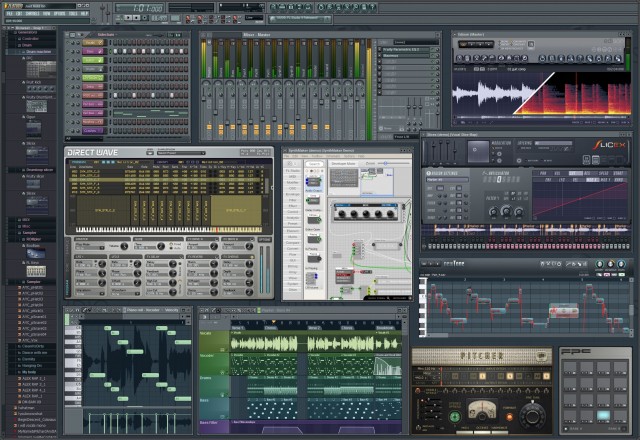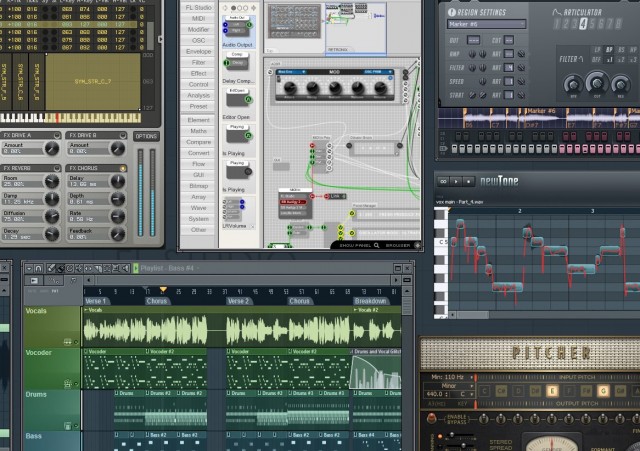FL Studio, aka Fruity Loops, has always been like opening a toybox of sound goodies for sound nerds – up to 30 instruments and 40+ effects in the latest edition. Just about every tool offers deep control for serious sound programmers, but there’s also a sense that those tools can be fun and immediate. And oddly, while developer Image-Line does introduce some instruments and effects as add-ons, all the functionality in the core program is covered by their lifetime free updates program. This isn’t feature bloat intended to entice you to upgrade; it’s more like what happens when you let the oompa-loompas run Willy Wonka and make whatever they want.
Or just forget all of that and think “FL Studio, the music app that makes you glad you’re running Windows.” (Don’t worry: fullscreen mode means you can actually even hide the fact that Windows is there at all.)
FL Studio 10 adds countless improvements to editing, from shortcuts to editing tools to display zoom, and gets smarter about working with 64-bit plug-ins and memory, as well as introducing new tools for manipulating audio pitch, time, harmony, and rhythm.
Among many new features in this version:
- More 64-bit: Automatic 64-bit plug-in support
- Smarter Memory Management, Audio Settings. Even on 32-bit Windows, you can get up to 2 GB of memory for plug-ins, with up to 192 GB for 64-bit Windows, and separate memory allocation for samples. There are also tweaks to ASIO audio performance.
- Better Mixer: Improved mixer views (with wide strips, at last), metering, and automatic delay compensation.
- Notation-ready, Smarter Piano Roll. It’s easier to edit with the piano roll view, thanks to new zoom, shortcuts, stretch handles (finally), display sync, and a “magic lasso.” It’s not just editing that’s better, though: you can also export directly to a PDF score by choosing Export.
- Better Playlist: The Playlist feature now has loop, pause, and skip options for more dynamic live backing tracks, plus new shortcuts for editing and previewing.
- File autosave and backup.
- A new Patcher that lets you save instrument and effect chains as single presets, visually. (Not SynthEdit – it’s a new way of patching together instruments and effects.)
- Optional add-ons for Celemony Melodyne-like pitch and time manipulation (Newtone) and pitch-correction, manipulation, and harmonization (Pitcher).
The addition of Pitcher is interesting, I think, because rival Propellerhead added their own take on this to Record in the form of Neptune.
If there were any comparison to make to FL Studio these days, Propellerhead’s software would be an obvious choice. But the two tools remain differentiated. Unlike Propellerhead’s dual Record/Reason offering, FL Studio is an all-in-one package, and it works as a plug-in and not just via ReWire. Record has more conventional mixing and arrangement tools than FL Studio, and the open signal patching interface in Reason and Record is unlike anything else available. And… actually, this list is so long as to not really fit in this article. But what I like about both is that you get a self-contained, unusual box of tools. Each has more of the sense of walking into a fully-stocked studio with some personality to it rather than a generic tool. (The generic approach has advantages, too, but the sense is different.)
FL’s capabilities remain:
- Flexibility: use it as a VST plug-in or connect via ReWire.
- Host anything: VST 32-bit and 64-bit, DX, and FL-native plugs.
- Multi-track audio and MIDI, with unique, tracker-like and step sequencer interfaces in addition to traditional piano roll and audio views.
- Unique built-in tools for manipulating audio, slicing and beat detection, warping, and now increasingly pitch and harmonization. (Yes, other tools do this, too, but FL has some unusual instruments and effects integrated with the workflow.)
FL Studio itself is really beyond comparison, a bundle of some of the best editing and instrument and effect tools out there. And that’s before you get to the stunningly-affordable pricing, which runs US$49 – $299 for download editions (up to $399 boxed, but I recommend the download version), all with free lifetime upgrades.
There’s just not a more affordable package in the long run, taking into account the breadth of the software and the endless upgrades.
You know where to go:
FL Studio 10
FL users, as always, I’d love to hear both what you think about the new release and how you use FL’s tools (new or old) in your work.
Update: yes, you can win things linking to FL, as Synthtopia notes. I’m not in love with this sort of marketing gimmick – I’m happy to write about FL purely based on its merits, personally – but it’ll certainly be awesome for you to win the prize, and if I for some reason do (which would be amusing), I’ll put the cash toward doing some free FL tutorials on CDM.
Full rules, if you want to enter:
$1010 competition
Of course, if you also link to CDM, I might just buy you a beer or two next time I see you. Odds of winning: 1 in 1. Beat that.

